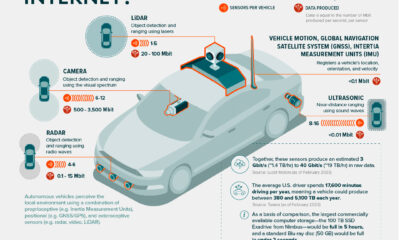Compared to other countries with fewer highways or narrower roads, the U.S. is very much a truck-friendly country. Across the U.S., the most sold vehicle in 2019 was the Ford F-Series of trucks, primarily the F-150. As the home of the world’s pioneer automotive manufacturers, including Ford and GM, consumers primarily purchase local brands. But that hasn’t stopped Toyota, the largest foreign manufacturer in the world, from also gaining a foothold. This graphic uses 2020 sales data from automotive information resource Edmunds.com, breaking down the best selling vehicles in each state through new vehicle retail registration.
What Are the Best Selling Vehicles in Each State?
Despite a slowdown in vehicle sales due to the COVID-19 pandemic and a global chip shortage, Americans still bought plenty of trucks last year. In fact, 48 out of the 50 states had a truck or SUV as the top selling vehicle in 2020—and most states actually had trucks taking all of the top three spots. The only two with a car topping the leaderboard were California and Florida. The Ford F-Series was the clear leader in sales, primarily in the Midwest. With a top-selling spot in 60% of U.S. states, the F-Series was the best selling vehicle in America. Combined with the Chevrolet Silverado and Ram 1500-3500 series, the big three American truck brands accounted for 73% of the top three selling vehicles across all American states and territories.
Japanese Automakers in the Mix
Though American manufacturers had the best selling cars in most states, they had some overseas competition. Japanese manufacturers Toyota and Honda had the top-selling vehicle in 11 states (and D.C.). They primarily captured car sales along the coastlines, including in California, Florida, New York and Washington, some of the most populated states in the country. Despite many cars being available for sale in the U.S., only seven manufacturers made the top-selling vehicles list in 2020.
Ford Ram Chevrolet Toyota Honda Subaru Jeep
With the full effects of the COVID-19 pandemic yet to be reflected in the sales, and electric vehicle manufacturers like Tesla on the rise, how will the best selling vehicles in America evolve? on Last year, stock and bond returns tumbled after the Federal Reserve hiked interest rates at the fastest speed in 40 years. It was the first time in decades that both asset classes posted negative annual investment returns in tandem. Over four decades, this has happened 2.4% of the time across any 12-month rolling period. To look at how various stock and bond asset allocations have performed over history—and their broader correlations—the above graphic charts their best, worst, and average returns, using data from Vanguard.
How Has Asset Allocation Impacted Returns?
Based on data between 1926 and 2019, the table below looks at the spectrum of market returns of different asset allocations:
We can see that a portfolio made entirely of stocks returned 10.3% on average, the highest across all asset allocations. Of course, this came with wider return variance, hitting an annual low of -43% and a high of 54%.
A traditional 60/40 portfolio—which has lost its luster in recent years as low interest rates have led to lower bond returns—saw an average historical return of 8.8%. As interest rates have climbed in recent years, this may widen its appeal once again as bond returns may rise.
Meanwhile, a 100% bond portfolio averaged 5.3% in annual returns over the period. Bonds typically serve as a hedge against portfolio losses thanks to their typically negative historical correlation to stocks.
A Closer Look at Historical Correlations
To understand how 2022 was an outlier in terms of asset correlations we can look at the graphic below:
The last time stocks and bonds moved together in a negative direction was in 1969. At the time, inflation was accelerating and the Fed was hiking interest rates to cool rising costs. In fact, historically, when inflation surges, stocks and bonds have often moved in similar directions. Underscoring this divergence is real interest rate volatility. When real interest rates are a driving force in the market, as we have seen in the last year, it hurts both stock and bond returns. This is because higher interest rates can reduce the future cash flows of these investments. Adding another layer is the level of risk appetite among investors. When the economic outlook is uncertain and interest rate volatility is high, investors are more likely to take risk off their portfolios and demand higher returns for taking on higher risk. This can push down equity and bond prices. On the other hand, if the economic outlook is positive, investors may be willing to take on more risk, in turn potentially boosting equity prices.
Current Investment Returns in Context
Today, financial markets are seeing sharp swings as the ripple effects of higher interest rates are sinking in. For investors, historical data provides insight on long-term asset allocation trends. Over the last century, cycles of high interest rates have come and gone. Both equity and bond investment returns have been resilient for investors who stay the course.













